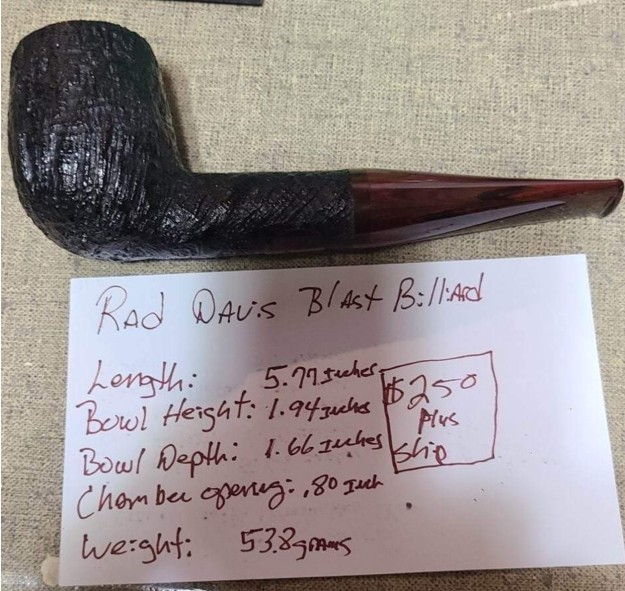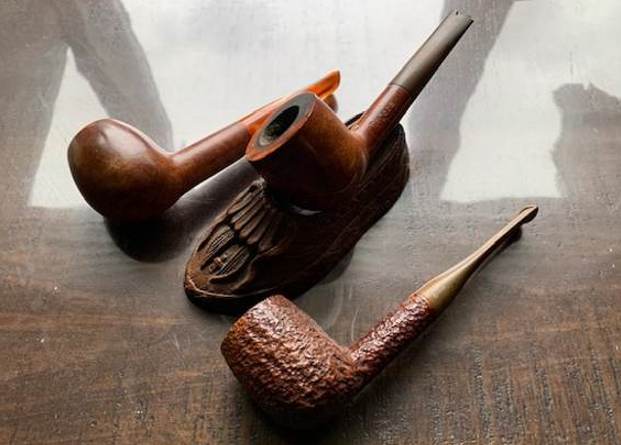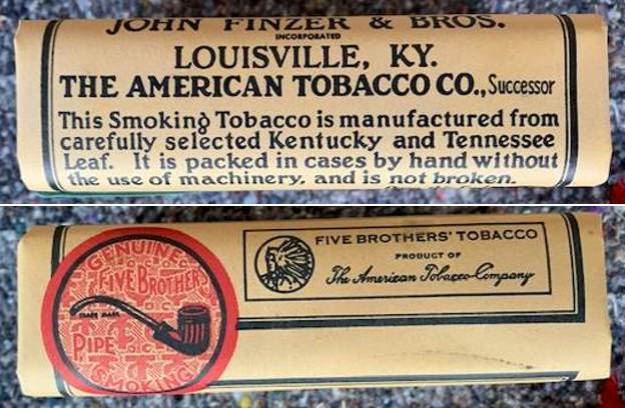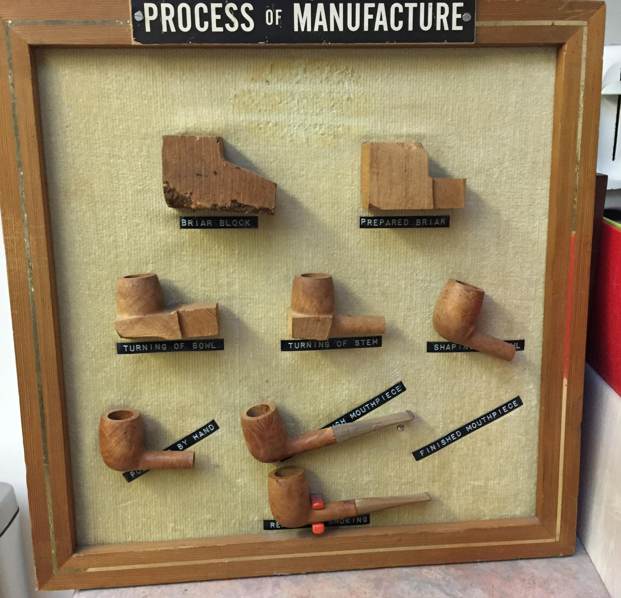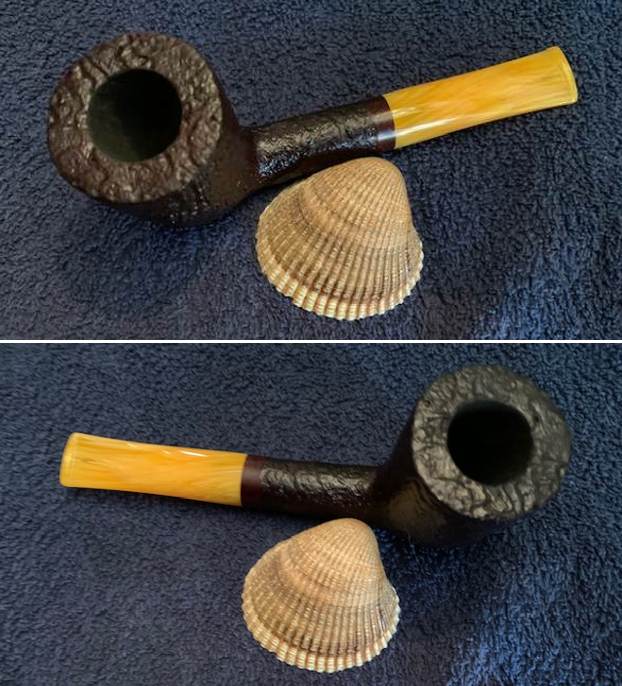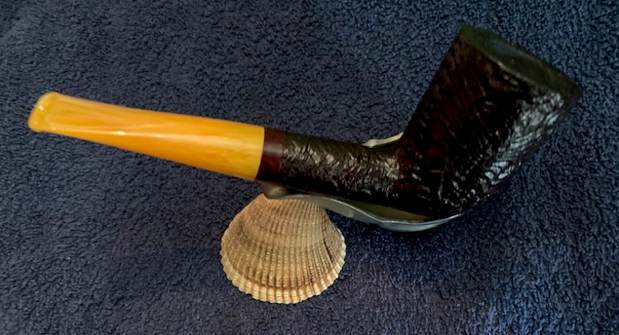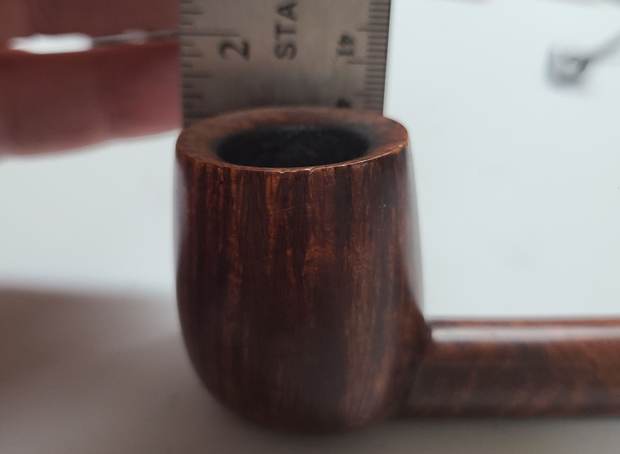Blog by Steve Laug
I can’t speak for you, I know that but for me there is nothing more exciting and enjoyable than wandering through an antique mall, shop, thrift shop or show with singular purpose and laser focus on finding whatever pipes lurk in the nooks and crannies of the shelves, displays and tables. Everywhere I travel I make time to do this. I have hunted pipes in London, Paris, Budapest, Sofia and Athens. In each of those cities and a plethora of North American cities I have found some incredibly interesting pipes. Because of that the rush of a pipe hunt, the expected finds and joys always are just below the surface when I get ready to hunt. Do you have the same experience in your pipe hunting? Do you have the same adrenaline rush as you prowl through a site like a carnivore hunting his prey? Does even the glint of a pipe give you a rush of excitement as you make your way to it? Does a great find make your heart beat faster? If you don’t, then what is wrong with you?
Once I see a pipe hidden in the detritus on a seller’s table every sense comes alive. There is a buzz that goes on in my head as I pick up a potential piece and examine it. I do all of this without expression or any external signals to the seller. I turn it over in my hands with bated breath hoping that it is a keeper. I check the stamping, the condition of the bowl, the stem condition, note issues that will need to be addressed. There are many other items that I go over as I turn it in my hands that are more a habit or feeling that I have more than a tangible thing I can define. After that I have to decide if I want to work on it. Notice I say want not if I can. I have learned that with a little ingenuity most things are fixable if I want to. But if I don’t want to it will sit here unfinished for a long time. If the pipe passes my assessment I remain quiet as I don’t want to give the seller any sense that the pipe is special and worth more than he is thinking. It really is a game for a good poker face. Then I ask the price and make my offer, always willing to walk away. If you experience this you will know that the brand is irrelevant in many ways as each of us has our own “holy grail” pipe that we dream of.
Some background for you on yesterday’s pipe hunt. Last year Kenneth Lieblich and I visited the Fraser Valley Antique and Collectible Club show in New Westminster. I brought along two of my daughters and we had a great time walking through all of the items that sellers had displayed. They found some things that interested them and we found a few pipes. We had a good laugh at the huge variation of prices that sellers were charging. They ranged from $8 to over $195 with no obvious rationale for the difference. It truly seemed to be a shot in the dark for them to arrive at a price. Some sellers were flexible and some were adamant that their old Dr. Grabow was worth hundreds. There were always those who loved to haggle and that for me was actually a part of the joy of the hunt. There will always be dreamers who think they hold a “special” pipe that everyone should be fighting over to own. More power to them. We would thank them, shake our heads and move on to another table. We had a great time together looking and then afterwards having coffee and visiting.
So, when Kenneth wrote about a month ago and sent me a link to the sale I did not need a lot of convincing. I wrote back that I was excited to go and if all humanly possible I would come.  The organizers describe the event as a two day show of over 200+ tables, tons of various endless vintage antiques & collectibles: vintage advertising tins and signs, oil & gas, toys, radios, fishing tackle, hunting & sports memorabilia, post cards, old photos, LP records, medalta, orange crush, Coca-Cola, Pepsi, moorcroft, movie posters, brewerania, fruit jars, soda pop / ginger beer bottles, drug stores, ephemera, old tools, books, Fire King Jadeite, Chinese Asian artifacts, tobacco, dolls, jewelry, stoneware pottery, comics, coins, stamps, Hudson Bay, Chinaware – hotel ware & restaurant ware, steamship, general store items, small vintage furniture – home decor, etc. – you name it; it’s here & you do not want to miss out! I did not want to miss out so it went on the calendar.
The organizers describe the event as a two day show of over 200+ tables, tons of various endless vintage antiques & collectibles: vintage advertising tins and signs, oil & gas, toys, radios, fishing tackle, hunting & sports memorabilia, post cards, old photos, LP records, medalta, orange crush, Coca-Cola, Pepsi, moorcroft, movie posters, brewerania, fruit jars, soda pop / ginger beer bottles, drug stores, ephemera, old tools, books, Fire King Jadeite, Chinese Asian artifacts, tobacco, dolls, jewelry, stoneware pottery, comics, coins, stamps, Hudson Bay, Chinaware – hotel ware & restaurant ware, steamship, general store items, small vintage furniture – home decor, etc. – you name it; it’s here & you do not want to miss out! I did not want to miss out so it went on the calendar.
So yesterday, April 27, 2024 we met at the arena at 8:45am and joined the queue of folks who were waiting to get inside. Kenneth brought his eldest daughter and I brought the same two with me as last year. There is always a lot of energy in the queue as folks discuss their hopes and expectations and catch up with each other. It is really a grand time. We chatted and introductions were made between the daughters. Kenneth and I enjoy these kinds of hunts. We wander down each aisle and carefully examine each sellers table for a potential pipe treasure that fits our demands! I say demands because over the years I have become ever more selective and sadly I seem to have passed that on to Kenneth.
Just before 9:00 am the doors opened and along with the waiting crowd we made our way into the arena. Like last year you paid at the door and immediately were in the midst of tables and sellers in the lobby area. We made our way through the tables and in the first few minutes came upon a seller with the typical overprice carved meerschaum figural and some Grabows and other drugstore pipes. However, in the midst of the pipe pile there was a Peterson’s System Standard Bowl sans stem. It was a 307 shape but was stamped 1307 which is something I will tell you about when I restem and restore it. We dickered and bartered and I added the first pipe to my pocket. We made our way to the arena and though it looks small it was crowded. I have included some photos from the advertising down by the Club for the event to give a sense of what we saw.
 It took us over an hour and a half to work our way through the tables two times to make sure we did not miss anything. We went down each row examining the offerings on the tables. We each found several pipes as we walked our way through. Kenneth and I would spot a few pipes and come together to go through them. It was great fun to discover a rack or a pile of old pipes to work through. The majority of the pipes were not for us. There were many Grabows, Medicos, other drug store pipes and even a few Figural Meerschaums. We would love them over and walk away. I must remember to bring a pocket lens with me next time. My eyesight combined with the lighting in the arena made it hard to clearly see the stamping on some of them. Each table provided the chance to look at things that the seller described as antiques or collectibles and to me some were neither. I felt my age as looked at toys I had played with, games I had enjoyed and household items that mom used to prepare and serve our meals. It was really a walk through my past.
It took us over an hour and a half to work our way through the tables two times to make sure we did not miss anything. We went down each row examining the offerings on the tables. We each found several pipes as we walked our way through. Kenneth and I would spot a few pipes and come together to go through them. It was great fun to discover a rack or a pile of old pipes to work through. The majority of the pipes were not for us. There were many Grabows, Medicos, other drug store pipes and even a few Figural Meerschaums. We would love them over and walk away. I must remember to bring a pocket lens with me next time. My eyesight combined with the lighting in the arena made it hard to clearly see the stamping on some of them. Each table provided the chance to look at things that the seller described as antiques or collectibles and to me some were neither. I felt my age as looked at toys I had played with, games I had enjoyed and household items that mom used to prepare and serve our meals. It was really a walk through my past.
Once we had finished going through the tables twice we went to the lobby and enjoyed a coffee and some hot chocolate. Kenneth and I went through our purchases. We both had some nice additions to our collections to work on. When I got home I took some photos of the finds of the hunt. As a group they look quite nice. I am sure Kenneth can add his finds if he chooses to do so.

 I took photos of each of pipes and have included how each one was stamped on the shank sides. I have also given a brief overview of the condition of the pipe.
I took photos of each of pipes and have included how each one was stamped on the shank sides. I have also given a brief overview of the condition of the pipe.
1. The first pipe shown below is stamped Jeantet [over] Fait Main on the left underside of the shank. On the right underside of the shank it is stamped with the number 4 (shape number?) and with Made in France along the shank/stem junction. There is a Jeantet logo J in a silver oval on the left topside of the diamond stem. It is kind of a Freehand Bent Dublin with a Diamond shank.
The pipe has some great grain around the bowl sides and shank. The rimtop is flat and slightly oval. The bowl had a moderate cake on the walls and thankfully no lava on the rim top or edges of the bowl. The stem was oxidized and had light toothmarks on the top and underside ahead of the button. 2. The second pipe shown below is stamped Jeantet [over] Fait Main on the top of left side of the shank. On the right side it is stamped with the shape number 9 [over] Made in France. There is a Jeantet logo J in a silver oval on the left topside of the stem. It is a bit of a Freehand Bent Apple with a unique stem shape.
2. The second pipe shown below is stamped Jeantet [over] Fait Main on the top of left side of the shank. On the right side it is stamped with the shape number 9 [over] Made in France. There is a Jeantet logo J in a silver oval on the left topside of the stem. It is a bit of a Freehand Bent Apple with a unique stem shape.
The pipe has some great grain around the bowl sides and shank. The rim top is slightly oval and bevelled inward toward the bowl. The bowl had a moderate cake on the walls and some lava on the rim top rear inner edge of the bowl. The stem was oxidized and had light toothmarks on the top and underside ahead of the button. 3. The third pipe shown below is stamped Peterson’s [over] System [over] Standard on the left side of the shank just below the nickel ferrule. On the right side it is stamped Made in the Republic of Ireland (in three lines) with the shape number 1307 below that. The nickel ferrule was stamped on the left side and read K&P Peterson’s [over] three classic Makers marks. These included a Shamrock, a Wolfhound and a Tower without a door. There was no stem with the pipe.
3. The third pipe shown below is stamped Peterson’s [over] System [over] Standard on the left side of the shank just below the nickel ferrule. On the right side it is stamped Made in the Republic of Ireland (in three lines) with the shape number 1307 below that. The nickel ferrule was stamped on the left side and read K&P Peterson’s [over] three classic Makers marks. These included a Shamrock, a Wolfhound and a Tower without a door. There was no stem with the pipe.
The pipe has some great grain around the bowl sides and shank. It is a large System Standard 307 shape with an extra number “1” included ahead of the 307. The bowl had a moderate cake on the walls and a thick lava coat on the rim top and inner edge of the bowl.  4. The fourth pipe shown below was stamped on a smooth panel on the underside of the shank with a shape number 625 followed by Brigham [over] Made in Canada Squat Straight Bulldog. The pipe has a typical rusticated finish on the bowl and a smooth rim cap.
4. The fourth pipe shown below was stamped on a smooth panel on the underside of the shank with a shape number 625 followed by Brigham [over] Made in Canada Squat Straight Bulldog. The pipe has a typical rusticated finish on the bowl and a smooth rim cap.
The pipe has some great grain around the bowl cap with an interesting rustication on the sides and shank. The bowl had a moderate cake on the walls and a thick lava coat on the rim top and the inner edge of the bowl. The stem was oxidized and slightly dirty with a single brass dot on the top of the saddle stem. There were light tooth marks on the top and underside ahead of the button. The metal tenon tube was seized in the shank making the stem unremovable. Looking at the pipes I brought home I was happy with what I had found. A usual I thoroughly enjoyed the hunt. It was truly a pleasure and the thrill of searching and finding can’t be matched. I only wish that I could do more of the hunting and finding. As I think about the trip I realize that one thing that would have added to the pleasure is if you could have been with us. If you have not gone on a pipe hunt you really should go. But until the at least we can tell you thanks for going with us on paper. Hope you had a good time.
Looking at the pipes I brought home I was happy with what I had found. A usual I thoroughly enjoyed the hunt. It was truly a pleasure and the thrill of searching and finding can’t be matched. I only wish that I could do more of the hunting and finding. As I think about the trip I realize that one thing that would have added to the pleasure is if you could have been with us. If you have not gone on a pipe hunt you really should go. But until the at least we can tell you thanks for going with us on paper. Hope you had a good time.
 First is a gorgeous black meerschaum billiard with an amber stem (not snapped – Deo gratias) and sterling silver bands around the shank and bowl. And it came with its proper case! I checked the hallmarks and they date this pipe to 1919 – a real old timer. Markings indicate that this is an Adolph Frankau. More on this pipe will come when I do some research.
First is a gorgeous black meerschaum billiard with an amber stem (not snapped – Deo gratias) and sterling silver bands around the shank and bowl. And it came with its proper case! I checked the hallmarks and they date this pipe to 1919 – a real old timer. Markings indicate that this is an Adolph Frankau. More on this pipe will come when I do some research. Second is a pipe that we thought was from Preben Holm – but isn’t. Doesn’t matter, it’s still a beauty. It’s made in Denmark by Granhill, which was a brand used by an American, Michael Kabik. This is a really well-made freehand pipe with a fine stem and stunning grain all over the bowl.
Second is a pipe that we thought was from Preben Holm – but isn’t. Doesn’t matter, it’s still a beauty. It’s made in Denmark by Granhill, which was a brand used by an American, Michael Kabik. This is a really well-made freehand pipe with a fine stem and stunning grain all over the bowl. Third is a really handsome rusticated pipe from Edward’s – a storied company from Florida that secretly stashed a bunch of Algerian briar during a time when it was hard to come by. I really like this shape and looking forward to cleaning it up.
Third is a really handsome rusticated pipe from Edward’s – a storied company from Florida that secretly stashed a bunch of Algerian briar during a time when it was hard to come by. I really like this shape and looking forward to cleaning it up. Fourth is a fascinating Peterson meerschaum Rhodesian. It has really neat colouring on the bowl and looks like it was greatly enjoyed by its previous owner. I assume that this pipe was made in the Isle of Man, as I believe all (or most) of Peterson’s meers were made there.
Fourth is a fascinating Peterson meerschaum Rhodesian. It has really neat colouring on the bowl and looks like it was greatly enjoyed by its previous owner. I assume that this pipe was made in the Isle of Man, as I believe all (or most) of Peterson’s meers were made there. Fifth is a cutty that’s a bit of a gamble. It isn’t fancy in any way, but it is well-drilled and well-fitted. It says KOOTENAY on the shank, which is a word I know from geography, but not from the world of pipes. Why did I buy it? Because the other side of the shank reads “Made in Canada” in a style that strongly resembles the pipes of the great Canadian artisan, Leonard Payne. More research will definitely be needed here.
Fifth is a cutty that’s a bit of a gamble. It isn’t fancy in any way, but it is well-drilled and well-fitted. It says KOOTENAY on the shank, which is a word I know from geography, but not from the world of pipes. Why did I buy it? Because the other side of the shank reads “Made in Canada” in a style that strongly resembles the pipes of the great Canadian artisan, Leonard Payne. More research will definitely be needed here. Sixth and last is a handsome French Lovat with no name of note, but a lot of character. It’s a real looker and I think it’s going to clean up really well.
Sixth and last is a handsome French Lovat with no name of note, but a lot of character. It’s a real looker and I think it’s going to clean up really well.















